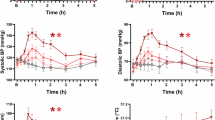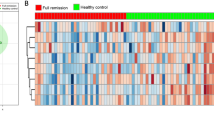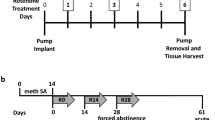Abstract
3,4-Methylenedioxy-N-methylcathinone (methylone) is a new psychoactive substance and the β-keto analog of 3,4-methylenedioxy-N-methylamphetamine (MDMA). It is well established that MDMA metabolism produces bioactive metabolites. Here we tested the hypothesis that methylone metabolism in rats can form bioactive metabolites. First, we examined the pharmacokinetics (PKs) of methylone and its metabolites after subcutaneous (sc) methylone administration (3, 6, 12 mg/kg) to male rats fitted with intravenous (iv) catheters for repeated blood sampling. Plasma specimens were assayed by liquid chromatography tandem mass spectrometry to quantify methylone and its phase I metabolites: 3,4-methylenedioxycathinone (MDC), 3,4-dihydroxy-N-methylcathinone (HHMC), and 4-hydroxy-3-methoxy-N-methylcathinone (HMMC). The biological activity of methylone and its metabolites was then compared using in vitro transporter assays and in vivo microdialysis in rat nucleus accumbens. For the PK study, we found that methylone and MDC peaked early (Tmax=15-45 min) and were short lived (t1/2=60–90 min), while HHMC and HMMC peaked later (Tmax=60-120 min) and persisted (t1/2=120–180 min). Area-under-the-curve values for methylone and MDC were greater than dose-proportional, suggesting non-linear accumulation. Methylone produced significant locomotor activation, which was correlated with plasma methylone, MDC, and HHMC concentrations. Methylone, MDC, and HHMC were substrate-type releasers at monoamine transporters as determined in vitro, but only methylone and MDC (1, 3 mg/kg, iv) produced significant elevations in brain extracellular dopamine and 5-HT in vivo. Our findings demonstrate that methylone is extensively metabolized in rats, but MDC is the only centrally active metabolite that could contribute to overall effects of the drug in vivo.
Similar content being viewed by others
Log in or create a free account to read this content
Gain free access to this article, as well as selected content from this journal and more on nature.com
or
References
Barrios L, Grison-Hernando H, Boels D, Bouquie R, Monteil-Ganiere C, Clement R (2015). Death following ingestion of methylone. Int J Legal Med 130: 381–385.
Baumann MH, Ayestas MA Jr ., Partilla JS, Sink JR, Shulgin AT, Daley PF et al (2012). The designer methcathinone analogs, mephedrone and methylone, are substrates for monoamine transporters in brain tissue. Neuropsychopharmacology 37: 1192–1203.
Baumann MH, Partilla JS, Lehner KR (2013). Psychoactive ‘bath salts’: not so soothing. Eur J Pharmacol 698: 1–5.
Baumann MH, Raley TJ, Partilla JS, Rothman RB (1993). Biosynthesis of dopamine and serotonin in the rat brain after repeated cocaine injections: a microdissection mapping study. Synapse 14: 40–50.
Baumann MH, Wang X, Rothman RB (2007). 3,4-Methylenedioxymethamphetamine (MDMA) neurotoxicity in rats: a reappraisal of past and present findings. Psychopharmacology 189: 407–424.
Baumann MH, Zolkowska D, Kim I, Scheidweiler KB, Rothman RB, Huestis MA (2009). Effects of dose and route of administration on pharmacokinetics of (+ or -)-3,4-methylenedioxymethamphetamine in the rat. Drug Metab Dispos 37: 2163–2170.
Carbone PN, Carbone DL, Carstairs SD, Luzi SA (2013). Sudden cardiac death associated with methylone use. Am J Forensic Med Pathol 34: 26–28.
Cawrse BM, Levine B, Jufer RA, Fowler DR, Vorce SP, Dickson AJ et al (2012). Distribution of methylone in four postmortem cases. J Anal Toxicol 36: 434–439.
Chu T, Kumagai Y, DiStefano EW, Cho AK (1996). Disposition of methylenedioxymethamphetamine and three metabolites in the brains of different rat strains and their possible roles in acute serotonin depletion. Biochem Pharmacol 51: 789–796.
Concheiro M, Baumann MH, Scheidweiler KB, Rothman RB, Marrone GF, Huestis MA (2014). Nonlinear pharmacokinetics of (+/-)3,4-methylenedioxymethamphetamine (MDMA) and its pharmacodynamic consequences in the rat. Drug Metab Dispos 42: 119–125.
Dal Cason TA, Young R, Glennon RA (1997). Cathinone: an investigation of several N-alkyl and methylenedioxy-substituted analogs. Pharmacol Biochem Behav 58: 1109–1116.
de la Torre R, Farre M (2004). Neurotoxicity of MDMA (ecstasy): the limitations of scaling from animals to humans. Trends Pharmacol Sci 25: 505–508.
de la Torre R, Farre M, Ortuno J, Mas M, Brenneisen R, Roset PN et al (2000). Non-linear pharmacokinetics of MDMA ('ecstasy') in humans. Br J Clin Pharmacol 49: 104–109.
Dinger J, Meyer MR, Maurer HH (2016). In vitro cytochrome P450 inhibition potential of methylenedioxy-derived designer drugs studied with a two-cocktail approach. Arch Toxicol 90: 305–318.
Drug Enforcement Administration DoJ (2011). Schedules of controlled substances: temporary placement of three synthetic cathinones in Schedule I. Final Order. Fed Regist 76: 65371–65375.
Drug Enforcement Administration DoJ (2013). Establishment of drug codes for 26 substances. Final rule. Fed Regist 78: 664–666.
Ellefsen K, Concheiro M, Suzuki M, Rice K, Elmore J, Baumann M et al (2015). Quantification of methylone and metabolites in rat and human plasma by liquid chromatography-tandem mass spectrometry. Forensic Toxicol 33: 202–212.
Eshleman AJ, Wolfrum KM, Hatfield MG, Johnson RA, Murphy KV, Janowsky A (2013). Substituted methcathinones differ in transporter and receptor interactions. Biochem Pharmacol 85: 1803–1815.
Glennon RA (2014). Bath salts, mephedrone, and methylenedioxypyrovalerone as emerging illicit drugs that will need targeted therapeutic intervention. Adv Pharmacol 69: 581–620.
Grecco GG, Sprague JE (2016). Impact of functional group modifications on designer phenethylamine induced hyperthermia. Chem Res Toxicol 29: 871–878.
Heydari A, Yeo KR, Lennard MS, Ellis SW, Tucker GT, Rostami-Hodjegan A (2004). Mechanism-based inactivation of CYP2D6 by methylenedioxymethamphetamine. Drug Metab Dispos 32: 1213–1217.
Kalivas PW, Duffy P, DuMars LA, Skinner C (1988). Behavioral and neurochemical effects of acute and daily cocaine administration in rats. J Pharmacol Exp Ther 245: 485–492.
Kamata HT, Shima N, Zaitsu K, Kamata T, Miki A, Nishikawa M et al (2006). Metabolism of the recently encountered designer drug, methylone, in humans and rats. Xenobiotica 36: 709–723.
Kankaanpaa A, Meririnne E, Lillsunde P, Seppala T (1998). The acute effects of amphetamine derivatives on extracellular serotonin and dopamine levels in rat nucleus accumbens. Pharmacol Biochem Behav 59: 1003–1009.
Kiyatkin EA, Kim AH, Wakabayashi KT, Baumann MH, Shaham Y (2015). Effects of social interaction and warm ambient temperature on brain hyperthermia induced by the designer drugs methylone and MDPV. Neuropsychopharmacology 40: 436–445.
Knoy JL, Peterson BL, Couper FJ (2014). Suspected impaired driving case involving alpha-pyrrolidinovalerophenone, methylone and ethylone. J Anal Toxicol 38: 615–617.
Kolbrich EA, Goodwin RS, Gorelick DA, Hayes RJ, Stein EA, Huestis MA (2008). Plasma pharmacokinetics of 3,4-methylenedioxymethamphetamine after controlled oral administration to young adults. Ther Drug Monit 30: 320–332.
Kovacs K, Toth AR, Kereszty EM (2012). [A new designer drug: methylone related death]. Orvosi Hetilap 153: 271–276.
Lopez-Arnau R, Martinez-Clemente J, Carbo M, Pubill D, Escubedo E, Camarasa J (2013). An integrated pharmacokinetic and pharmacodynamic study of a new drug of abuse, methylone, a synthetic cathinone sold as ‘bath salts’. Prog Neuropsychopharmacol Biol Psychiatry 45: 64–72.
Lopez-Arnau R, Martinez-Clemente J, Pubill D, Escubedo E, Camarasa J (2014). Serotonergic impairment and memory deficits in adolescent rats after binge exposure of methylone. J Psychopharmacol 28: 1053–1063.
McIntyre IM, Hamm CE, Aldridge L, Nelson CL (2013). Acute methylone intoxication in an accidental drowning—a case report. Forensic Sci Int 231: e1–e3.
McKenna DJ, Guan XM, Shulgin AT (1991). 3,4-Methylenedioxyamphetamine (MDA) analogues exhibit differential effects on synaptosomal release of 3H-dopamine and 3H-5-hydroxytryptamine. Pharmacol Biochem Behav 38: 505–512.
Nash JF, Nichols DE (1991). Microdialysis studies on 3,4-methylenedioxyamphetamine and structurally related analogues. Eur J Pharmacol 200: 53–58.
Pedersen AJ, Petersen TH, Linnet K (2013). In vitro metabolism and pharmacokinetic studies on methylone. Drug Metab Dispos 41: 1247–1255.
Ridpath A, Driver CR, Nolan ML, Karpati A, Kass D, Paone D et al (2014). Illnesses and deaths among persons attending an electronic dance-music festival - New York City, 2013. MMWR Morb Mortal Wkly Rep 63: 1195–1198.
Rothman RB, Baumann MH, Dersch CM, Romero DV, Rice KC, Carroll FI et al (2001). Amphetamine-type central nervous system stimulants release norepinephrine more potently than they release dopamine and serotonin. Synapse 39: 32–41.
Sandtner W, Stockner T, Hasenhuetl PS, Partilla JS, Seddik A, Zhang YW et al (2016). Binding mode selection determines the action of ecstasy homologs at monoamine transporters. Mol Pharmacol 89: 165–175.
Schindler CW, Thorndike EB, Blough BE, Tella SR, Goldberg SR, Baumann MH (2014). Effects of 3,4-methylenedioxymethamphetamine (MDMA) and its main metabolites on cardiovascular function in conscious rats. Br J Pharmacol 171: 83–91.
Schindler CW, Thorndike EB, Goldberg SR, Lehner KR, Cozzi NV, Brandt SD et al (2016). Reinforcing and neurochemical effects of the ‘bath salts’ constituents 3,4-methylenedioxypyrovalerone (MDPV) and 3,4-methylenedioxy-N-methylcathinone (methylone) in male rats. Psychopharmacology 233: 1981–1990.
Simmler LD, Buser TA, Donzelli M, Schramm Y, Dieu LH, Huwyler J et al (2013). Pharmacological characterization of designer cathinones in vitro. Br J Pharmacol 168: 458–470.
Vandewater SA, Creehan KM, Taffe MA (2015). Intravenous self-administration of entactogen-class stimulants in male rats. Neuropharmacology 99: 538–545.
Warrick BJ, Wilson J, Hedge M, Freeman S, Leonard K, Aaron C (2012). Lethal serotonin syndrome after methylone and butylone ingestion. J Med Toxicol 8: 65–68.
Watterson LR, Hood L, Sewalia K, Tomek SE, Yahn S, Johnson CT et al (2012). The reinforcing and rewarding effects of methylone, a synthetic cathinone commonly found in ‘bath salts’. J Addict Res Ther Suppl 9: pii 002.
Wichems CH, Hollingsworth CK, Bennett BA (1995). Release of serotonin induced by 3,4-methylenedioxymethamphetamine (MDMA) and other substituted amphetamines in cultured fetal raphe neurons: further evidence for calcium-independent mechanisms of release. Brain Res 695: 10–18.
Wu D, Otton SV, Inaba T, Kalow W, Sellers EM (1997). Interactions of amphetamine analogs with human liver CYP2D6. Biochem Pharmacol 53: 1605–1612.
Author information
Authors and Affiliations
Corresponding author
Rights and permissions
About this article
Cite this article
Elmore, J., Dillon-Carter, O., Partilla, J. et al. Pharmacokinetic Profiles and Pharmacodynamic Effects for Methylone and Its Metabolites in Rats. Neuropsychopharmacol 42, 649–660 (2017). https://doi.org/10.1038/npp.2016.213
Received:
Revised:
Accepted:
Published:
Issue date:
DOI: https://doi.org/10.1038/npp.2016.213
This article is cited by
-
In vitro toxicokinetics and metabolic profiling of methoxycathinones and methylthiocathinones using human liver systems and hyphenated mass spectrometry
Archives of Toxicology (2025)
-
An updated review on synthetic cathinones
Archives of Toxicology (2021)
-
Pharmacokinetics of Synthetic Cathinones Found in Bath Salts in Mouse Brain and Plasma Using High-Pressure Liquid Chromatography–Tandem Mass Spectrometry
European Journal of Drug Metabolism and Pharmacokinetics (2021)
-
A review of the influence of functional group modifications to the core scaffold of synthetic cathinones on drug pharmacokinetics
Psychopharmacology (2019)
-
Reinforcing Effects of Binary Mixtures of Common Bath Salt Constituents: Studies with 3,4-Methylenedioxypyrovalerone (MDPV), 3,4-Methylenedioxymethcathinone (methylone), and Caffeine in Rats
Neuropsychopharmacology (2018)



